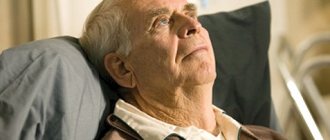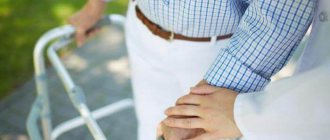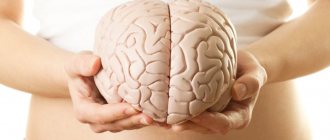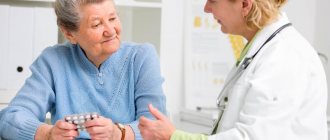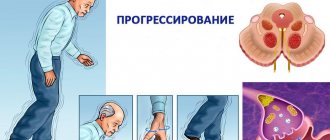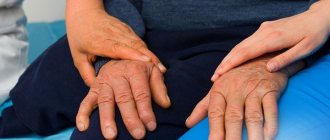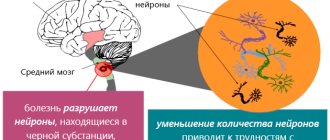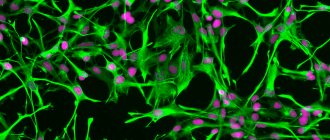The first signs of Parkinson's disease, modern methods of treatment
Parkinson's disease is a chronic degenerative disease of the nervous system in which a person loses the ability to control their movements. The disease develops relatively slowly, but has a tendency to progress. It is a fairly common problem - 4% of the elderly population suffer from manifestations of parkinsonism.
The development of the disease is based on changes that occur in the substantia nigra of the brain. The cells in this area are responsible for producing the chemical dopamine. It mediates signal transmission between neurons in the substantia nigra and striatum in the brain. Violation of this mechanism leads to the fact that a person loses the ability to coordinate his movements.
Epidemiology
Parkinson's disease accounts for 70-80% of cases of parkinsonism syndrome. It is the most common neurodegenerative disease after Alzheimer's disease.
The disease occurs everywhere. Its frequency ranges from 60 to 140 people per 100 thousand population, the number of patients increases significantly among representatives of the older age group. The proportion of people with Parkinson's disease in the age group over 60 years old is 1%, and over 85 years old - from 2.6% to 4%. Most often, the first symptoms of the disease appear at 55-60 years of age. However, in some cases, the disease can develop before the age of 40 (early-onset Parkinson's disease) or before 20 years of age (juvenile form of the disease).
Men get sick slightly more often than women. There were no significant racial differences in the incidence pattern.
Description
Parkinson's disease is a chronic pathology with slow progression.
With it, there is a gradual death and death of neurons that produce the neurotransmitter dopamine. The lack of this substance leads to a disruption in the functioning of the cerebral cortex, which is why the symptoms of the pathology arise. The disease remains incurable, and therapy is carried out only to alleviate the patient’s condition. Also, proper treatment helps reduce the rate of progression of the disease, which is especially important when it is detected in youth.
In men, the disease occurs somewhat more often than in women, and occurs in a more severe form.
A person's nationality does not change the likelihood of developing the disease.
Parkinson's disease in women
The peculiarity of the pathology in women is due to the fact that estrogens take an active part in the production of the neurotransmitter dopamine.
This property reduces the risk of Parkinson's disease in women if they do not experience hormonal imbalances. This same feature also leads to the fact that among women the number of patients increases sharply in the period after menopause, when estrogen levels drop. For the occurrence of the disease, an early onset of menopause is considered a particularly favorable factor, which indicates hormonal weakness. The risk of getting the disease is slightly higher in women who have had 3 or more pregnancies, as this condition affects hormonal levels.
A particular risk of developing the disease is the removal of the ovaries or serious impairment of their function due to diseases, due to which the level of estrogen in the body falls catastrophically.
Parkinson's disease in men
No specific features of the pathology were identified in men.
Male hormones also influence the formation of pathology and the degree of its development. The only difference from the female form of the disease is that Parkinson's disease is more common in the stronger sex and begins at an earlier age. Symptoms are the same for both sexes.
Parkinson's disease in older people
The disease appears due to age-related changes against the background of the natural aging process in brain tissue.
This phenomenon is usually preceded by injury, infectious brain damage or stroke. The disorder is accompanied by other symptoms of brain tissue destruction in the elderly.
Parkinson's disease in young people
Cases of the onset of Parkinson's disease in young people, in the age group from 20 to 40 years, are not frequent.
They account for about 10% of the total number of cases. The disease progresses noticeably more slowly than in old age, and its symptoms are somewhat blurred and not very bright. In most patients, at the beginning of the development of pathology, only minor pain is observed during muscle contractions in the extremities. This symptom is quite similar to how arthritis manifests itself, which complicates diagnosis. Later, involuntary muscle contractions may occur in the limbs or body, which cause noticeable pain. As the disease develops, characteristic symptoms of its clinical course become noticeable, characteristic of patients of any age. From now on, making the correct diagnosis is no longer difficult. Therapy, as in elderly patients, is only supportive.
Parkinson's disease - causes
The exact causes of Parkinson's disease remain a mystery to this day, however, some factors, coming to the fore, still take on the leading function, and therefore are considered to be the culprits of this pathology.
These include:
- Aging of the body, when the number of neurons naturally decreases, and, therefore, the production of dopamine decreases;
- Some medications used to treat various diseases and, as a side effect, have an effect on the extrapyramidal structures of the brain (aminazine, rauwolfia preparations);
- Environmental factors: permanent residence in rural areas (treatment of plants with substances intended to destroy agricultural pests), near railways, highways (transportation of environmentally hazardous goods) and industrial enterprises (harmful production);
- Hereditary predisposition (the gene for the disease has not been identified, but the family pattern is indicated - 15% of patients have relatives suffering from parkinsonism);
- Acute and chronic neuroinfections (for example, tick-borne encephalitis);
- Vascular cerebral pathology;
- Poisoning with carbon monoxide and heavy metal salts;
- Brain tumors and injuries.
At the same time, when considering the causes of Parkinson’s disease, it is worth noting an interesting fact that pleases smokers and coffee lovers. For those who smoke, the “chance” of getting sick is reduced by 3 times. It is said that tobacco smoke has such a “beneficial” effect because it contains substances resembling MAOIs (monoamine oxidase inhibitors), and nicotine stimulates the production of dopamine. As for caffeine, its positive effect lies in its ability to increase the production of dopamine and other neurotransmitters.
Forms and stages of the disease
There are several forms of the disease:
| Trembling-rigid | in this situation, trembling is a typical sign. A similar pathology is diagnosed in 37% of cases. |
| Rigid trembling | the main signs are general slowness of movements and increased muscle tone. This symptomatology is observed in approximately 21% of cases. |
| Trembling | At the beginning of development, the main symptom is trembling. At the same time, muscle tone does not increase, and slowness of movements or poor facial expressions appear slightly. This type of pathology is diagnosed in 7% of cases. |
| Akinetic-rigid | trembling may be completely absent or appear slightly - for example, during periods of excitement. This type of disease is detected in 33% of cases. |
| Akinetic | characterized by the absence of voluntary movements. This type of pathology occurs in only 2% of cases. |
The generally accepted gradation of stages of the disease, reflecting the degree of severity, is as follows:
- stage 0 – absence of motor disorders;
- stage 1 – unilateral nature of the manifestations of the disease;
- stage 2 – bilateral manifestations of the disease, the ability to maintain balance is not affected;
- stage 3 – moderately severe postural instability, the patient is able to move independently;
- stage 4 – severe loss of motor activity, the ability to move is preserved;
- stage 5 - the patient is bedridden or wheelchair-bound, and movement without assistance is impossible.
The modified Hoehn and Yarh scale (Hoehn and Yarh, 1967) suggests the following division into stages:
- stage 0.0 – no signs of parkinsonism;
- stage 1.0 – unilateral manifestations;
- stage 1.5 – unilateral manifestations involving the axial muscles (neck muscles and muscles located along the spine);
- stage 2.0 – bilateral manifestations without signs of imbalance;
- stage 2.5 – mild bilateral manifestations, the patient is able to overcome the caused retropulsion (the patient accelerates backward when pushed from the front);
- stage 3.0 – moderate or moderate bilateral manifestations, slight postural instability, the patient does not need outside assistance;
- stage 4.0 – severe immobility, the patient’s ability to walk or stand without support is preserved;
- stage 5.0 – the patient is confined to a chair or bed without assistance.
Stages
There are five main stages in the development of Parkinson's disease.
At stage 1, trembling appears in only one arm or leg. Usually the disease manifests itself as trembling of the fingers of the right hand.
At stage 2, trembling (tremor) spreads to the second arm (leg). Sleep is disturbed, appetite worsens, excessive salivation occurs, and the chin begins to twitch.
At stage 3, balance is disturbed, body posture changes, the gait becomes shuffling and slow, but the person can still perform ordinary everyday movements and take care of himself. The tremor becomes more and more intensified, speech is impaired, the face becomes emotionless.
At stage 4, changes in gait and body posture become more pronounced. While walking, a person may fall. He can still walk, but can no longer perform simple actions or take care of himself (fasten buttons, hold a spoon). Depression develops.
At stage 5, a person loses the ability to move (walk, stand, sit), coordination of movements is lost. Speech becomes illegible, slurred, swallowing and urination are impaired. Without outside help, his life becomes impossible.
The progression of the disease can be slow, moderate or rapid. In the first case, the transition from one stage to another occurs within five years or longer, in the second case - within 3 - 5 years, in the third case - within two years.
Symptoms of Parkinson's disease
In the early stages of development, Parkinson's disease is difficult to diagnose due to the slow development of clinical symptoms (see photo). It can manifest as pain in the extremities, which can be mistakenly associated with diseases of the spine. Depressive states can often occur.
The main manifestation of parkinsonism is akinetic-rigid syndrome, which is characterized by the following symptoms:
- Tremor. It is a rather dynamic symptom. Its appearance can be associated both with the emotional state of the patient and with his movements. For example, a tremor in the hand may decrease during conscious movements, and increase when walking or moving the other hand. Sometimes it may not exist. The frequency of oscillatory movements is small - 4-7 Hz. They can be observed in the arm, leg, and individual fingers. In addition to the extremities, trembling may occur in the lower jaw, lips and tongue. The characteristic parkinsonian tremor in the thumb and index finger resembles “pill rolling” or “coin counting.” In some patients, it may occur not only at rest, but also during movement, causing additional difficulties when eating or writing.
- Rigidity. Movement disorders caused by akinesia are aggravated by rigidity - increased muscle tone. Upon external examination of the patient, it is manifested by increased resistance to passive movements. Most often, it is uneven, which causes the appearance of the “gear wheel” phenomenon (there is a feeling that the joint consists of gear wheels). Normally, the tone of the flexor muscles prevails over the tone of the extensor muscles, so rigidity in them is more pronounced. As a result, characteristic changes in posture and gait are noted: the torso and head of such patients are tilted forward, the arms are bent at the elbows and brought to the body, the legs are slightly bent at the knees (“supplicant pose”).
- Bradykinesia. It represents a significant slowdown and impoverishment of motor activity, and is the main symptom of Parkinson's disease. It manifests itself in all muscle groups, but is most noticeable on the face due to the weakening of facial muscle activity (hypomimia). Due to the rare blinking of the eyes, the gaze seems heavy and piercing. With bradykinesia, speech becomes monotonous and muffled. Due to impaired swallowing movements, drooling may occur. Fine motor skills of the fingers are also depleted: patients have difficulty making familiar movements, such as fastening buttons. When writing, transient micrographia is observed: towards the end of the line, the letters become small and illegible.
- Postural instability. It is a special disorder of coordination of movements when walking, caused by the loss of postural reflexes involved in maintaining balance. This symptom appears at a late stage of the disease. Such patients experience some difficulty in changing posture, changing direction of movement, and starting to walk. If you push the patient out of balance with a small push, he will be forced to take several quick short steps forward or backward (propulsion or retropulsion) in order to “catch up” with the center of gravity of the body and not lose balance. The gait becomes mincing, “shuffling.” The consequence of these changes is frequent falls. Postural instability is difficult to treat and is often the reason why a patient with Parkinson's disease becomes bedridden. Movement disorders in parkinsonism are often combined with other disorders.
Mental disorders:
- Cognitive disorders (dementia) - memory is impaired, slow vision appears. With a severe course of the disease, serious cognitive problems arise - dementia, decreased cognitive activity, the ability to reason sensibly, and express thoughts. There is no effective way to slow the development of dementia, but clinical studies show that the use of Rivastigmine and Donepezil somewhat reduces such symptoms.
- Emotional changes - depression, it is the very first symptom of Parkenson's disease. Patients lose self-confidence, are afraid of new situations, avoid communication even with friends, pessimism and irritability appear. You experience increased sleepiness during the day, disturbed sleep at night, nightmares, and overly emotional dreams. It is unacceptable to use any medications to improve sleep without a doctor's recommendation.
Autonomic disorders:
- Orthostatic hypotension is a decrease in blood pressure when changing body position (when a person stands up suddenly), this leads to a decrease in blood supply to the brain, dizziness and sometimes fainting.
- Gastrointestinal disorders are associated with impaired intestinal motility - constipation associated with inertia, poor nutrition, and limited drinking. Constipation is also caused by taking anti-parkinsonism medications.
- Decreased sweating and increased skin greasiness - the skin on the face becomes oily, especially in the area of the nose, forehead, and head (provokes the occurrence of dandruff). In some cases, it may be the other way around, the skin becomes too dry. Conventional dermatological treatment improves skin condition.
- Increased urination or, conversely, difficulty emptying the bladder.
Other characteristic symptoms:
- Difficulty eating - this is due to limited motor activity of the muscles responsible for chewing and swallowing, and increased salivation occurs. Retention of saliva in the mouth can lead to choking.
- Problems with speech - difficulty starting a conversation, monotony of speech, repetition of words, too fast or slurred speech is observed in 50% of patients.
- Sexual dysfunction - depression, taking antidepressants, poor circulation lead to erectile dysfunction and decreased sexual desire.
- Muscle pain - aches in the joints and muscles are caused by poor posture and muscle stiffness, the use of levodopa reduces such pain, and certain types of exercise also help.
- Muscle spasms - due to lack of movement in patients (muscle stiffness), muscle spasms occur, more often in the lower extremities; massage, warming, and stretching help to reduce the frequency of cramps.
- Fatigue, weakness - increased fatigue usually worsens in the evening and is associated with problems starting and ending movements; it can also be associated with depression and insomnia. Establishing a clear sleep and rest schedule, and reducing physical activity helps reduce fatigue.
It is worth noting that the course of the disease is individual for each person. Therefore, some symptoms may predominate, while others may be mild. Signs of the disease are amenable to drug therapy. In some cases, surgery can effectively combat the disease.
Clinical manifestations
All signs of Parkinson's disease are caused by the destruction of neurons. These cells perform various functions, from moving the fingers to controlling the functioning of internal organs. Depending on which cells are damaged as a result of pathological biochemical reactions or the action of external factors, the disease can have different manifestations. When diagnosing parkinsonism, a tetrad of symptoms is distinguished, which can occur individually or in combination:
- tremor - trembling of the limbs;
- rigidity - muscle weakness;
- hypokinesia - decreased mobility;
- decreased postural control—impaired balance and control of body position in space.
Muscle tremors are one of the most obvious symptoms of Parkinson's disease. It can be noticed already in the initial stages of the disease, when other clinical signs have not had time to form. Muscle rigidity is easily detected in the later stages of parkinsonism, but may go unnoticed in the early stages. During diagnosis, the symmetry of the tone of the limbs is of great importance. A characteristic feature of true parkinsonism is the asymmetrical manifestation of symptoms.
Hypokinesia is a slowness of movements, as well as a decrease in their number and amplitude. In the early stages, this symptom is almost invisible, but there are ways to detect it. So, the patient is asked to perform simple movements (bend his fingers into a fist). If this action cannot be performed quickly and symmetrically, this becomes a basis for suspicion of Parkinson's disease. In the later stages, hypokinesia begins to manifest itself in everyday life. It is difficult for the patient to fasten clothes, eat food, perform hygiene and other procedures. The motor function of the facial and masticatory muscles may also be impaired. In this regard, a person develops atypical gestures and speech becomes unclear.
In addition to changes in muscle condition, the patient is concerned about additional symptoms of Parkinson's disease, and in some cases they come to the fore. These include insomnia, uncontrolled drooling, disorders of the digestive and urinary systems, dementia and other manifestations. Parkinsonism is also characterized by restless legs syndrome, a condition in which the patient experiences discomfort in the lower extremities and constantly moves them to relieve well-being.
Stages of Parkinson's disease
Pathological changes in the functioning of the central nervous system develop in stages. In the first stages, the disease may be asymptomatic, and you can determine it yourself only when the signs become more pronounced. The first classification distinguishes 3 degrees of development of parkinsonism, determined by the general clinical picture and the need to take specific medications:
- early - does not require regular medication, the patient remains fully functional;
- extensive - at this stage the patient is already prescribed medication, but the physical ability to perform any tasks can be maintained;
- late - the patient may lose the ability to perform basic self-care, and the risk of developing complicated forms increases.
There is another classification that doctors around the world use when diagnosing Parkinson’s disease (according to Hoehn-Yahr). She distinguishes 5 successive stages of pathology:
- first - motor manifestations can be noted, but only on one side;
- second - symptoms begin to be noticeable on both sides;
- third - the patient experiences a slight lack of coordination of movements, the gait becomes unstable, but the person still does not lose the ability to self-care;
- fourth - motor activity is significantly limited, as a result of which the person needs outside help to move;
- fifth - a person practically loses the ability to move and is constantly in a horizontal or sitting position.
The signs of Parkinson's disease are identical in women and men. In addition, the disease can first appear at any age, including in young people under 25 years of age. Indeed, in most cases it is diagnosed in the elderly, but the characteristic symptoms cannot be ignored if they occur in young women or men.
Diagnostics
Comprehensive diagnosis of the disease is based on the study of the neurological status, patient complaints and a combination of a number of criteria.
Among the instrumental research methods, the most reliable is positron emission tomography (PET), in which radioactive fluorodopa is injected intravenously and the degree of its accumulation in specific areas of the brain is assessed. The disadvantage of the method is its high cost and low prevalence. Other laboratory and instrumental methods do not reliably identify the causes of the disease and prescribe its treatment, therefore they are used to exclude other diseases with similar symptoms.
To make a diagnosis, a combination of hypokinesia with one or more signs (rest tremor (frequency 4-6 Hz), muscle rigidity, postural disturbances) is necessary.
Treatment, correction
Correction of the disease is possible
Treatment is selected individually for each patient depending on the stage of his disease. The main goal of therapy is to reduce the rate of progression of the pathology and prolong the patient’s comfortable life for as long as possible.
For this, in addition to drug therapy, specially designed physical therapy exercises are prescribed, as well as measures aimed at maximizing the maintenance of motor activity. If necessary, symptomatic treatment is also carried out to relieve negative reactions.
The basic drug used to inhibit the disease is levodopa. However, this medicine has a number of side effects that must be taken into account when prescribing it to a specific patient. If it is impossible to use this medicine, drugs are selected that can replace it as efficiently as possible.
Physical therapy is one of the widely used methods that allows you to highly effectively relieve muscle manifestations of the disease. Taking into account the general condition and physical activity of the patient, an individual set of exercises is developed for him.
With this treatment, it is important to follow the sequence of actions, avoid skipping exercises, and also visit a doctor regularly. When a patient cannot do the prescribed exercises on his own, he should be helped, since physical therapy cannot be abandoned.
Surgery is a last resort if other treatments are ineffective. The main method is neurostimulation. It is minimally invasive. It involves the action of an electric current directed to a strictly defined area of the brain.
Important! Treatment and correction for adults and children are the same.
Treatment of Parkinson's disease
This disease is incurable; all modern drugs for therapy only alleviate the symptoms of Parkinson's disease. Symptomatic treatment is aimed at eliminating movement disorders.
How to treat Parkinson's disease? In the early stages of the disease, feasible physical activity and physical therapy are indicated. Treatment with drugs should be started as late as possible, since with long-term use of medications, the patient develops addiction, a forced increase in dosage and, as a result, increased side effects.
- For severe clinical manifestations of parkinsonism, levodopa is currently the basic drug, usually in combination with a decarboxylase inhibitor. Doses are increased slowly over several weeks until clinical effect is achieved. Side effects of the drug are dystonic disorders and psychosis. Levodopa, entering the central nervous system, is decarboxylated into dopamine, which is necessary for the normal function of the basal ganglia. The drug affects primarily akinesia and, to a lesser extent, other symptoms. When combining levodopa with a decarboxylase inhibitor, the dose of levodopa can be reduced and thereby reduce the risk of side effects.
- In the arsenal of symptomatic antiparkinsonian drugs, a large place is occupied by anticholinergic drugs, which, by blocking m- and n-cholinergic receptors, promote relaxation of striated and smooth muscles, reduce violent movements and the phenomena of bradykinesia. These are natural and synthetic atropine-like drugs: bellazone (romparkin), norakin, combipark. Phenothiazine drugs are also used: dynesin, deparkol, parsidol, diprazine. The main reason for the variety of medications used to treat parkinsonism is their insufficient therapeutic effectiveness, the presence of side effects, individual intolerance and rapid addiction to them.
- The morphological and biochemical changes in Parkinson's disease are so complex, and the course of the disease and its consequences are so severe, and are also aggravated by the effects of replacement therapy - levodopa, that the treatment of such patients is considered the height of medical skill and is subject to virtuosos - neurologists. Therefore, special centers for the treatment of parkinsonism are open and operating, where the diagnosis is clarified, observation is carried out, and doses of necessary drugs and treatment regimens are selected. You cannot prescribe or take medications on your own.
For replacement therapy, levodopa, carbidopa, and nacom are used. Adamantine, memantine, bromocriptine stimulate the release of dopamine, inhibit the process of dopamine reuptake - anticholinesterase drugs and tricyclic antidepressants (amitriptyline), inhibit the breakdown of dopamine selegiline, antioxidants are used as neuroprotectors of DA neurons - selegiline, tocopherol, calcium channel blockers - nifidipine.
In the early stages, the use of pramipexole (Mirapex) has been proven to preserve quality of life. It is a first-line drug for the treatment of Parkinson's disease with a high level of efficacy and safety. The treatment uses umex, neomidantan, neuroprotectors, and antioxidants. Patients need therapeutic exercises according to an individual program - to move as much as possible and stay active longer.
Symptoms
The symptoms of the disease include several groups of very clear signs that help in diagnosis.
Depending on the stage of the pathology and its intensity, they will be more or less pronounced.
- Trembling - tremor
. A periodic or constant involuntary phenomenon that develops due to excessive stimulation of muscles by the nervous system. The limbs, head, eyelids and lower jaw suffer from it to a greater extent. - Decreased muscle mobility and stiffness - rigidity
. Since there is no inhibitory effect of dopamine, which is in short supply, increased muscle tone develops. They become excessively hard and immobile, as a result, elasticity is lost and a constant feeling of stiffness develops. - Decreased motor activity – hypokinesia
. It occurs due to the destruction of the basal ganglia, which are responsible for a person’s performance of various movements. With such insufficiency, stiffness, immobility, slowing of movement and a decrease in the frequency of blinking develop. - Slowing of speech, thinking and emotional reactions – bradefrenia
. The development of the condition is caused by the destruction of nerve cells and a drop in dopamine levels. Reactions and thinking are inhibited, as are the expression of emotions and speech. - Loss of ability to maintain balance, loss of stability
. The basal ganglia are responsible for maintaining balance and proper movement during walking. Their destruction leads to disruption of movements and the functioning of the vestibular apparatus. A person moves in small steps, slow and uncertain. - Mental vegetative disorders
. The general functioning of the nervous system during the disease deviates significantly from the norm, which is why first serious disturbances in thinking and memory are formed, and then insomnia and dementia.
Since the symptoms of the disease are quite similar to a number of other age-related and non-age-related mental disorders, the patient requires an examination to accurately determine the pathology.
Neurostimulation
Neurostimulation is a modern treatment method that is a minimally invasive neurosurgical operation.
This method is used in the following cases:
- Despite correctly selected drug therapy, the patient is unable to achieve a significant reduction in symptoms.
- The patient is socially active and is afraid of losing his job due to the disease.
- Progression of the disease leads to the need to increase doses of medications, and the side effects of the drugs become intolerable.
- The patient loses the ability to care for himself and becomes dependent on his family to perform daily activities.
Results of the operation:
- Allows non-invasive adjustment of stimulation settings as the disease progresses;
- Unlike palidotomy and thalamotomy, it is reversible;
- The period of effective control over the symptoms of the disease increases;
- The need for antiparkinsonian medications is significantly reduced;
- Can be bilateral (that is, effective for symptoms on both sides of the body);
- It is easily tolerated and is a safe method.
Disadvantages of neurostimulation:
- Relatively high cost;
- Possibility of electrodes moving or breaking; in these cases (15%) repeat surgery is needed;
- The need to replace the generator (after 3-7 years);
- Some risk of infectious complications (3-5%).
The essence of the method: the therapeutic effect is achieved by stimulating certain brain structures responsible for controlling body movements with a precisely calculated small amplitude electric current. To do this, thin electrodes are inserted into the patient's brain and connected to a neurostimulator (similar to a pacemaker) implanted subcutaneously in the chest area under the collarbone.
Treatment using stem cells.
The results of the first trials on the use of stem cells in Parkinson's disease were published in 2009. According to the data obtained, 36 months after the introduction of stem cells, a positive effect was observed in 80% of patients. The treatment involves transplanting neurons obtained from differentiated stem cells into the brain. Theoretically, they should replace dead dopamine-secreting cells. As of the second half of 2011, the method has not been sufficiently studied and does not have widespread clinical application.
In 2003, for the first time, genetic vectors containing the gene responsible for the synthesis of glutamate decarboxylase were introduced into the subthalamic nucleus of a person with Parkinson's disease. This enzyme reduces the activity of the subthalamic nucleus. As a result, it has a positive therapeutic effect. Despite the good treatment results obtained, as of the first half of 2011, the technique is practically not used and is in the stage of clinical trials.
Physiotherapy
Patients may develop joint contractures as a result of impaired tone and hypokinesia, for example, shoulder-scapular periarthrosis. Patients are recommended to follow a low-cholesterol diet and a low-protein diet. For normal absorption of levodopa, protein products should be taken no earlier than an hour after taking the medicine. Psychotherapy and reflexology are indicated.
Maintaining physical activity stimulates the production of internal (endogenous) neurotransmitters. Scientific research is being conducted on the treatment of parkinsonism: these include stem and dopamine-producing cells, a vaccine against Parkinson’s disease, surgical treatment - thalamotomy, pallidotomy, high-frequency deep stimulation of the subthalamic nucleus or the internal segment of the globus pallidus and new pharmacological drugs.
Complications and prognosis
Parkinson's disease in any case ends in disability or death. This can occur both within the first 5 years from the onset of the disease, and after 15 or more years. The prognosis depends on the individual characteristics of the body, the reaction to the use of medications and the timeliness of starting to take them. As complications, patients develop disturbances in the processes of chewing and swallowing, which causes severe disability. In addition, it can cause respiratory tract infections.
The Clinical Brain Institute has all the resources and qualified staff to diagnose and treat Parkinson's disease. Here you can undergo a comprehensive examination if you suspect the onset of neurological disorders, as well as for the purpose of prevention. It is worth remembering that timely seeking medical help significantly increases the chances of prolonging life and maintaining working capacity for many years.
Clinical Brain Institute Rating: 4/5 — 5 votes
Share article on social networks
Folk remedies
The patient will not be able to cope without drug treatment. Traditional medicine methods for Parkinson's disease will only slightly alleviate his condition.
- Patients often suffer from sleep disturbances; they may wake up repeatedly during the night and walk around the room in a half-asleep state. In doing so, they bump into furniture and can seriously injure themselves. Therefore, a patient suffering from parkinsonism should create an extremely comfortable environment for night rest.
- The patient will benefit from foot baths with fern decoction. To prepare the decoction you need to take 5 tbsp. l. dry rhizomes, add 5 liters of water and boil for at least 2 hours. Cool the broth and prepare a foot bath.
- A mixture of freshly squeezed juices of plantain leaves, nettle and celery will help reduce clinical manifestations.
- Herbal teas are prepared from linden blossom, chamomile, sage or thyme. It is better to take plants separately, adding to 1 tbsp. l. substrate 1 tsp. dry motherwort herb for a sedative effect. At 2 tbsp. l. of the medicinal plant, take 500 ml of boiling water and infuse it in a bowl covered with a towel.
Before using any products from this category, you should consult your doctor!
Forecast for life
The prognosis is conditionally unfavorable - Parkinson's disease is steadily progressing. Symptoms of movement disorders develop most quickly. Patients who do not receive treatment, on average, lose the ability to care for themselves after 8 years from the onset of the disease, and after 10 years they become bedridden.
- As of the second half of 2011, the vast majority of patients are receiving appropriate treatment. The prognosis in this group is better compared to patients who do not receive adequate therapy. Individuals taking levodopa become dependent on their caregivers after an average of 15 years. However, in each specific case the rate of progression of the disease is different. It has been noted that with the relatively early development of Parkinson's disease, symptoms of impaired motor activity progress most quickly, and when the first symptoms of the disease appear in people 70 years of age and older, mental disorders come to the fore.
- Adequate therapy slows down the development of a number of symptoms leading to disability in patients (muscle rigidity, hypokinesia, postural instability, etc.). However, 10 years after the onset of the disease, the working capacity of most patients is significantly reduced.
The life expectancy of patients is reduced. The ability to work in these patients is permanently and irreversibly lost; depending on the severity of neurological disorders, patients are assigned a disability group.
Methods for diagnosing the disease
Although Parkinson's disease has no cure, it should be diagnosed in its early stages. This way, you can prescribe a course of drug treatment in time to slow down the processes of neuronal destruction and the progression of symptoms. The patient is examined in 3 successive stages, on the basis of which a final diagnosis can be made.
The first stage consists of a visual examination of the patient’s reflexes and motor activity. To begin with, a differential diagnosis of true parkinsonism from false one is carried out. In order to make a preliminary diagnosis of Parkinson's disease and continue the examination, it is necessary to simultaneously identify several clinical signs of the pathology. The first of them is hypokinesia, a decrease in motor activity of any degree. Additionally, one or more symptoms may appear:
- tremor of the limbs at rest;
- muscle weakness, rigidity;
- decreased postural control not associated with vestibular disorders, pathologies in the visual areas of the brain or cerebellum.
If several symptoms are confirmed, you can proceed to the second stage of diagnosis. Next, it is necessary to distinguish true parkinsonism from false, that is, diseases that occur with a similar neurological picture. To do this, a number of criteria are excluded that indicate the absence of Parkinson's disease:
- oculogyric crisis (gaze convulsion) is a condition in which the patient’s gaze is directed up and to the side (less often down or to the side), an attack can last from several minutes to several hours;
- taking antipsychotics immediately before the onset of neurological syndrome;
- history of strokes, traumatic brain injuries or encephalitis of various origins;
- long period of remission;
- the presence of only unilateral manifestations during the last 3 years;
- symptoms of cerebellar damage;
- too early and severe clinical picture of dementia;
- Babinski reflex - extension of the first toe in response to irritation of the outer edge of the sole of the foot;
- presence of tumors in the brain;
- fact of MPTP intoxication;
- lack of a positive effect in response to the use of large doses of levodopa.
At the third stage, it is necessary to confirm the presence of clinical signs that directly indicate the development of Parkinson's disease. They can appear separately or in combination, and gradually progress with the development of the disease. These include:
- tremor of the limbs at rest;
- unilateral manifestation of motor symptoms, especially in the early stages;
- in most cases, a positive reaction to levodopa therapy and the effectiveness of such treatment for 5 years or more;
- duration of symptoms - they do not disappear even 10 years after their debut.
During diagnosis, the patient is prescribed a comprehensive examination. The most effective methods are CT and MRI of the brain, rheoencephalography, electroencephalography, neuroimaging and others. The Clinical Brain Institute specializes in the diagnosis and treatment of patients of any age who exhibit signs of Parkinson's disease. Here you can get advice from practicing specialists of a wide and narrow profile, undergo a comprehensive examination and be observed by doctors during therapy.
Differential diagnosis
Before starting treatment, it is important to ensure that the diagnosis is correct. Since Parkinson's disease has similar manifestations to other neurological disorders, its diagnosis is carried out, among other things, by excluding these diseases. These include secondary and false parkinsonism. According to statistics, about 80% of cases are due to Parkinson's disease, but for some patients the parkinsonism syndrome is concomitant.
Prevention
In order to reduce the risk of Parkinson's disease, you should adhere to the following preventive measures:
- Timely diagnose and treat vascular pathologies of the brain associated with injuries or infections. In this way, dysfunction of dopamine production will be avoided.
- Follow the timing of taking neurolipeptic drugs. They can be used for no more than 1 month without interruption.
- Consult a doctor if you notice the slightest signs of Parkinson's disease.
- Substances that are really able to protect neurons are flavonoids and anthocyanins. They can be found in apples and citrus fruits.
- It is worth protecting the nervous system by avoiding stress, leading a healthy lifestyle, and exercising.
- Increasing scientific evidence indicates that smokers and coffee drinkers have virtually no incidence of Parkinson's disease. But this is a rather specific preventive measure that should not be considered as a recommendation. Moreover, when a disease is detected, there is no point in starting to smoke or drink coffee, since this does not in any way affect the course of pathological processes. However, in the absence of contraindications, you can consume minimal doses of natural coffee on a regular basis.
- It is beneficial to eat a diet that is rich in B vitamins and fiber.
- Avoid contact with harmful substances that affect the development of the disease, such as manganese, carbon monoxide, opiates, pesticides.
New research shows that berries can have an impact on the risk of disease.
